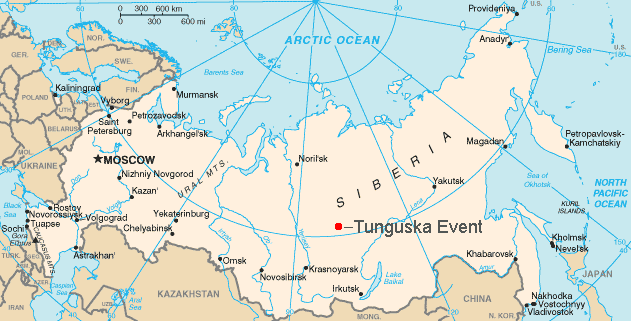|
Tungussko-Chunsky District
Tungussko-Chunsky district was a former district (raion) of the former Evenk Autonomous Okrug which was merged into Krasnoyarsk Krai on 1 January 2007. Location Tungussko-Chunsky district was located in the south-east of the Evenk Autonomous Okrug. The total area of the district was 111,600km2 - the district's length from west to east at the widest point was 340 kilometres, and from north to south was 540 kilometres. When the district was created, the administrative centre was the village of Strelka-Chunya. However, in 1935, the administrative centre was changed to the village of Vanavara. The reason for the change was the distance of Strelka-Chunya from the district's main waterway, Podkammenoy Tunguski, which caused difficulties in communication with other settlements in the district. The district contained 5 settlements (postal codes in brackets): * The village of Vanavara (648490) - population 2,943 * The village of Mutoray (648483) - population 90 * The village of Oskoba ... [...More Info...] [...Related Items...] OR: [Wikipedia] [Google] [Baidu] |
Evenk Autonomous Okrug
Evenk Autonomous Okrug (russian: Эвенки́йский автоно́мный о́круг, ; , ), or Evenkia, was a federal subject of Russia (an autonomous okrug of Krasnoyarsk Krai). It had been created in 1930. Its administrative center was the urban-type settlement of Tura. As of 2006, at 767,600 km, it was Russia's seventh largest federal subject, and the country's least populous: In 1999, the governor of Krasnoyarsk, General Alexander Lebed, demanded the recognize the central district government of Krasnoyarsk had authority over it, which the refused to do, causing a power struggle between the central district and the 's government.National Geographic. ''The Book of Peoples''. Page 139 Following a referendum on the issue held on April 17, 2005, Evenk and Taymyr Autonomous Okrugs were merged into Krasnoyarsk Krai effective January 1, 2007 (some Evenks contested the results, however). Administratively, they are now considered to be districts with special sta ... [...More Info...] [...Related Items...] OR: [Wikipedia] [Google] [Baidu] |
Krasnoyarsk Krai
Krasnoyarsk Krai ( rus, Красноя́рский край, r=Krasnoyarskiy kray, p=krəsnɐˈjarskʲɪj ˈkraj) is a federal subject of Russia (a krai), with its administrative center in the city of Krasnoyarsk, the third-largest city in Siberia (after Novosibirsk and Omsk). Comprising half of the Siberian Federal District, Krasnoyarsk Krai is the largest krai in the Russian Federation, the second largest federal subject (after neighboring Sakha) and the third largest subnational governing body by area in the world, after Sakha and the Australian state of Western Australia. The krai covers an area of , which is nearly one quarter the size of the entire country of Canada (the next-largest country in the world after Russia), constituting roughly 13% of the Russian Federation's total area and containing a population of 2,828,187 (more than a third of them in the city of Krasnoyarsk), or just under 2% of its population, per the 2010 Census. Geography The krai lies in the middl ... [...More Info...] [...Related Items...] OR: [Wikipedia] [Google] [Baidu] |
Vanavara (rural Locality)
Vanavara (russian: Ванавара) is a rural locality (a '' selo'') in Evenkiysky District of Krasnoyarsk Krai, Russia, located on the Podkamennaya Tunguska River at the mouth of the local Vanavarki River. Population: Vanavara is notable for being the nearest populated place to the site of the 1908 Tunguska event. History The locality as it exists today was founded in 1932 as a base for herders, hunters, and fishermen, as well as a location for a weather station. A plane crash occurred on September 26, 1994, when a plane flying from Krasnoyarsk to Tura had diverted to Vanavara Airport due to bad weather: on running out of fuel the crew then attempted an emergency landing on the bank of the Chamba River 41 km from Vanavara centre. All twenty-four passengers and four crew died in the crash. On December 10, 2010, an explosion occurred in a boiler in the heating plant in Vanavara. A fireman was killed in the incident and heating was cut off for 720 ... [...More Info...] [...Related Items...] OR: [Wikipedia] [Google] [Baidu] |
Tunguska Event
The Tunguska event (occasionally also called the Tunguska incident) was an approximately 12-megaton explosion that occurred near the Podkamennaya Tunguska River in Yeniseysk Governorate (now Krasnoyarsk Krai), Russia, on the morning of June 30, 1908. The explosion over the sparsely populated Eastern Siberian Taiga flattened an estimated 80 million trees over an area of of forest, and eyewitness reports suggest that at least three people may have died in the event. The explosion is generally attributed to a meteor air burst: the atmospheric explosion of a stony asteroid about in size. The supposed asteroid approached from the east-southeast, and likely with a relatively high speed of about (~ Ma 80). It is classified as an impact event, even though no impact crater has been found; the object is thought to have disintegrated at an altitude of rather than having hit the surface of the Earth. The Tunguska event is the largest impact event on Earth in recorded history, thou ... [...More Info...] [...Related Items...] OR: [Wikipedia] [Google] [Baidu] |


